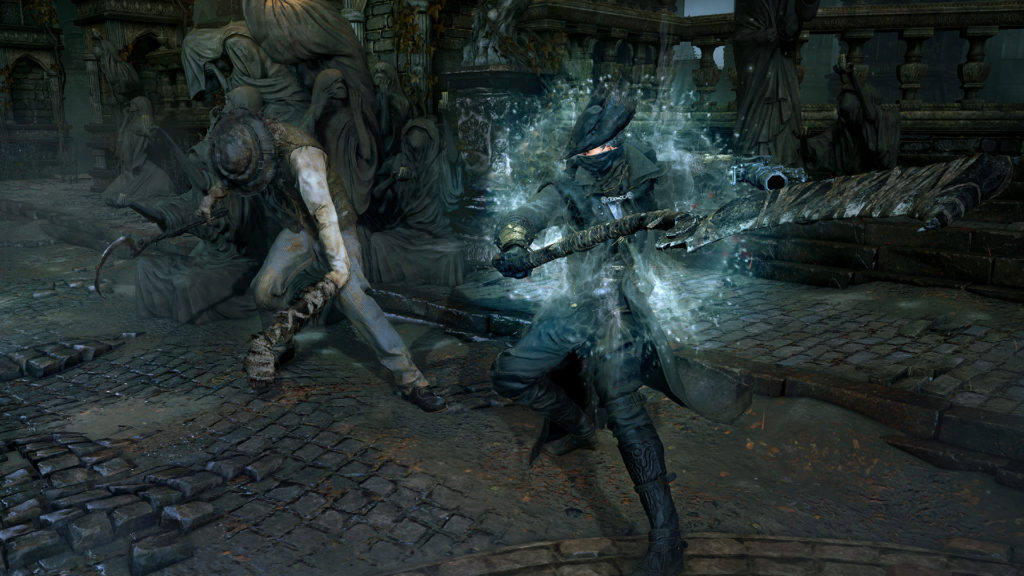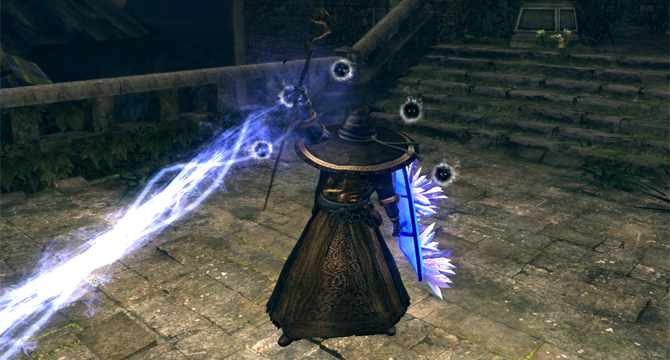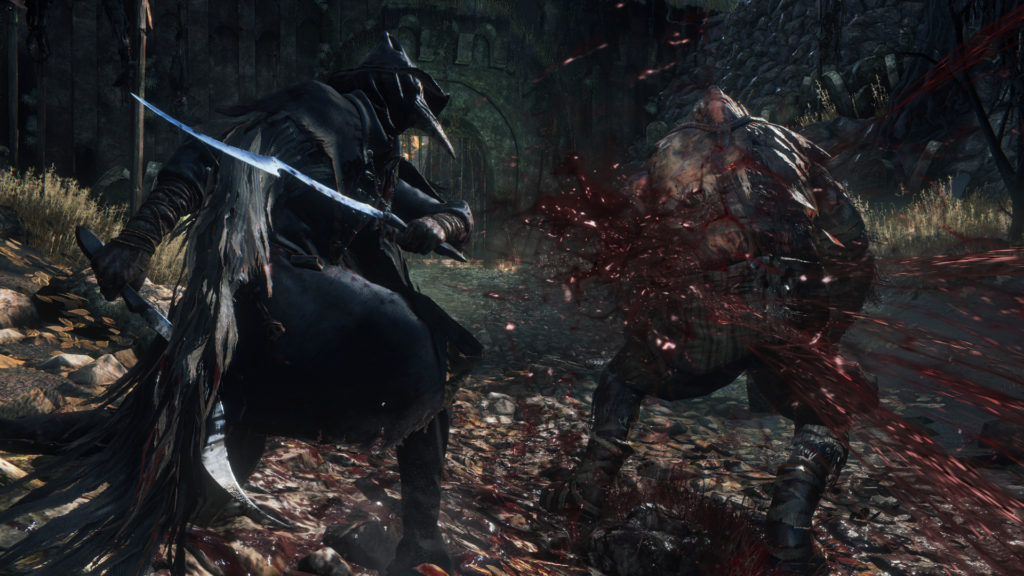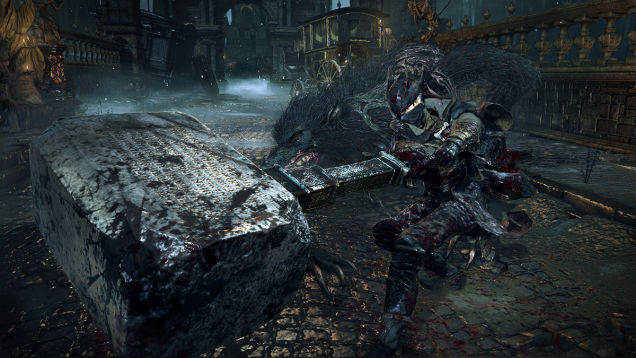
So I have a PS4. Despite saying I wouldn’t own one for a good long while, a combination of the cost to upgrade/buy a new gaming PC and a 64 dollar coupon told me different, and so I now own one. And, for whatever reason, I found a mint copy of Bloodborne at a Redbox near my house for $8.99 USD. It was seemingly untouched by anybody in my area, which both makes perfect sense and makes me very sad, because Bloodborne feels like the best Souls game I’ve yet played!
A lot of that comes down to Bloodborne’s unwavering focus towards melee combat. One thing has always bugged me about the Souls games: the variety of options. On the one hand, this means you can “play the game your way”, so to speak, or at least experience the illusion of picking the equipment/weapons/magic/whatever of your choice to beat the game. This makes for a lot of variety, and a lot of interesting switches for subsequent playthroughs. But, that same freedom means that From Software can’t really tailor a level to one kind of playstyle over another. In other words, they need to make sure melee-focused and ranged-focused characters alike receive an equal amount of challenge. Naturally, one set of characters ends up with a much greater challenge in certain sections just by virtue of their playstyle, which always sat wrong with me.

The original Dark Souls highlights this more than any other game in the series, because magic makes a good portion of the game absolutely trivial. Most enemies seem designed with melee combat in mind, so when you add ranged attacks, the AI of the enemies only have so many tools to take you down from a distance, if at all. I think I can safely call it “easy-mode”, and I lack any interest in playing the game this way despite it being optimal. Something just feels wrong when I simply spam magic spells from afar, as if I’m depriving myself of an experience.
Bloodborne does not have this problem, at all. Because of lore, setting, or whatever, Miyazaki provides us with a completely melee-focused game that amps the speed and forces you to play aggressively. You can dodge and move incredibly quickly in this game, and so can the enemies; while a lot of the same principles apply, you’re actively punished for playing too defensively. Attacking a lot staggers enemies, which prevents them from attacking you – that’s key to survival, since you really don’t want enemies to unload their long, varied attack strings. Since melee remains your primary means to attack, there’s no escaping a close encounter with enemies, and nearly every foe seems designed for that purpose – a welcome change! Attacks are no longer single hit affairs, but combo strings – clearly, some inspiration was taken from fighting games!

There’s other mechanical reasons to stay aggressive, such as the Regain system. Bloodborne assumes that you’ll take hits in combat, so it allows you to regain health if you attack something successfully within a certain period of time. This means you’re constantly on the look-out for an opening, and you’ll want to take such risks to keep your supply of Blood Vials (Estus Flask, pretty much) high. Further, taking a huge risk with a parry (here activated via pistol by pressing a button as soon as an enemy attack would land) brings you the reward of Visceral Attacks, which can decimate foes (think backstab and the like).
And, to add on top of all these risk/reward mechanics, Bloodborne removes the safety of the shield from your inventory. I can tell you this is quite a change for a guy who relied on the sword/shield combo throughout every single Souls game; there’s no such crutch here, and Bloodborne forces you to adapt or die. Add tons of multiple enemy encounters, combined with your increased movement speed and dodging ability, and most encounters are calculated, fast, and exhilarating affairs.
You constantly dodge, weave, and attack, finding opening and experimenting with the unique movesets of each weapon. In the place of magic, we end up with Trick Weapons. Each one is unique, with its own individual moveset, and they can be transformed to create yet another moveset! The Hunter’s Axe looks like a short-range heavy axe, but pressing the Trick Weapon button switches it to a long range pike that can cut a wide swathe. The real fun comes when you press the attack button in sequence with the Trick Weapon button, which allows you to switch forms in the middle of combos. This means you can figure out the quickest combos for a particular enemy and abuse them into a combo string that starts with a fast attack, then switches to a giant hammer (I love the Kirkhammer. It’s crazy).

All this is to say, from a first 3-hours perspective, I think Bloodborne might be my favorite of all the Souls games. It’s removed a lot of the fat from the game’s systems, and in its place are interesting, active mechanics that encourage active experimentation and decision-making on the fly. Sure, it’s fundamentally a Souls game on some level, but the tiny differences are enough to give Bloodborne an unwavering focus towards a particular kind of experience. In that way, it succeeds brilliantly.
I think the same principles of good game design also apply to video games – in this case, it’s pretty striking how a few little changes can make for a much more exciting experience! I am absolutely taking this next verse out of context:
16 So because you are lukewarm, and neither hot nor cold, I will [a]spit you out of My mouth.
Revelation 3:16
But I think it applies here. Laodicea, as a town (not just as a church), was known as sort of an in-between town; while some towns surrounding it had hot springs, and other had cool mountain water flowing through the city, Laodicea’s well could only muster a lukewarm water. Hence, the reference here was a metaphor that the church in Laodicea would immediately understand (and, we assume, they did) – sitting in the middle doesn’t fix anything, nor does it lead to true faith. Sometimes, you need to jump down on God’s side of the fence to truly understand the right way to live.
And why can’t this apply to game design too? Bloodborne goes all-in on melee combat, and I think they did a great job with it because they didn’t go halfway with it. The game forces a commitment from the player to get right into the thick of it, and it’s all the better for it!
